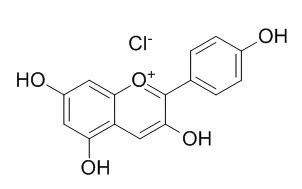| In vitro: |
| Frontiers in Pharmacology, 2017, 8:868. | | Pelargonidin Modulates Keap1/Nrf2 Pathway Gene Expression and Ameliorates Citrinin-Induced Oxidative Stress in HepG2 Cells.[Reference: WebLink] | Pelargonidin chloride (PC) is one of the major anthocyanin found in berries, radish and other natural foods. Many natural chemopreventive compounds have been shown to be potent inducers of phase II detoxification genes and its up-regulation is important for oxidative stress related disorders.
METHODS AND RESULTS:
In the present study, we investigated the effect of PC in ameliorating citrinin (CTN) induced cytotoxicity and oxidative stress. The cytotoxicity of CTN was evaluated by treating HepG2 (Human hepatocellular carcinoma) cells with CTN (0-150 μM) in a dose dependent manner for 24 h, and the IC50 was determined to be 96.16 μM. CTN increased lactate dehydrogenase leakage (59%), elevated reactive oxygen species (2.5-fold), depolarized mitochondrial membrane potential as confirmed by JC-1 monomers and arrested cell cycle at G2/M phase. Further, apoptotic and necrotic analysis revealed significant changes followed by DNA damage. To overcome these toxicological effects, PC was pretreated for 2 h followed by CTN exposure for 24 h. Pretreatment with PC resulted in significant increase in cell viability (84.5%), restored membrane integrity, reactive oxygen species level were maintained and cell cycle phases were normal. PC significantly up-regulated the activity of detoxification enzymes: heme oxygenase 1 (HO-1), glutathione transferase, glutathione peroxidase, superoxide dismutase and quinone reductase. Nrf2 translocation into the nucleus was also observed by immunocytochemistry analysis.
CONCLUSIONS:
These data demonstrate the protective effect of PC against CTN-induced oxidative stress in HepG2 cells and up-regulated the activity of detoxification enzyme levels through Keap1/Nrf2 signaling pathway. | | Biochem Pharmacol, 1996, 52(7):1033-1039. | | Inhibition of lipid peroxidation and the active oxygen radical scavenging effect of anthocyanin pigments isolated from Phaseolus vulgaris L.[Reference: WebLink] |
METHODS AND RESULTS:
No attention has been paid to anthocyanin pigments from the viewpoint of inhibitors of lipid peroxidation and scavengers of active oxygen radicals; therefore, we investigated the antioxidative, radical scavenging, and inhibitory effects on lipid peroxidation by UV light irradiation of three anthocyanin pigments, pelargonidin 3-O-beta-D-glucoside (P3G), cyanidin 3-O-beta-D-glucoside (C3G), and delphinidin 3-O-beta-D-glucoside (D3G), isolated from the Phaseolus vulgaris L. seed coat, and their aglycons, Pelargonidin chloride (Pel), cyanidin chloride (Cy), and delphinidin chloride (Del).
CONCLUSIONS:
All pigments had strong antioxidative activity in a liposomal system and reduced the formation of malondialdehyde by UVB irradiation. On the other hand, the extent of antioxidative activity in a rat liver microsomal system and the scavenging effect of hydroxyl radicals (-OH) and superoxide anion radicals (O2-) were influenced by their own structures. |
|






 Cell. 2018 Jan 11;172(1-2):249-261.e12. doi: 10.1016/j.cell.2017.12.019.IF=36.216(2019)
Cell. 2018 Jan 11;172(1-2):249-261.e12. doi: 10.1016/j.cell.2017.12.019.IF=36.216(2019) Cell Metab. 2020 Mar 3;31(3):534-548.e5. doi: 10.1016/j.cmet.2020.01.002.IF=22.415(2019)
Cell Metab. 2020 Mar 3;31(3):534-548.e5. doi: 10.1016/j.cmet.2020.01.002.IF=22.415(2019) Mol Cell. 2017 Nov 16;68(4):673-685.e6. doi: 10.1016/j.molcel.2017.10.022.IF=14.548(2019)
Mol Cell. 2017 Nov 16;68(4):673-685.e6. doi: 10.1016/j.molcel.2017.10.022.IF=14.548(2019)